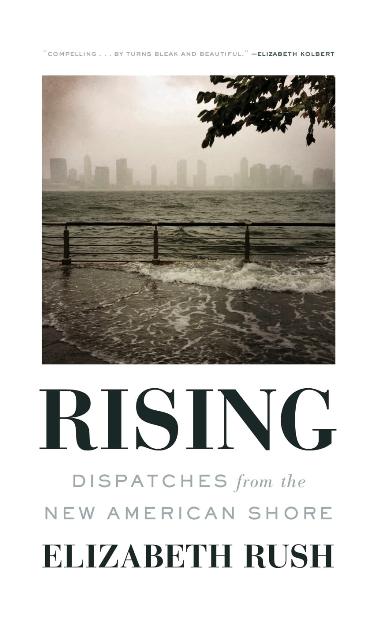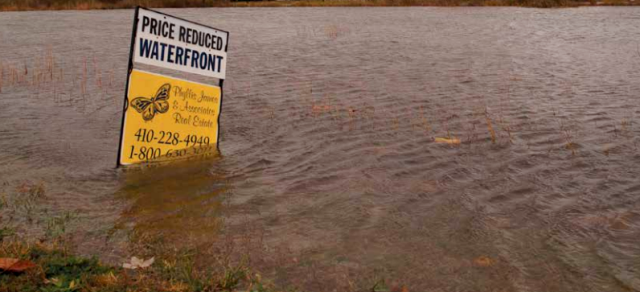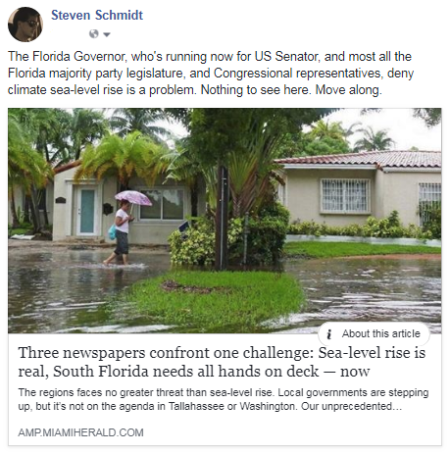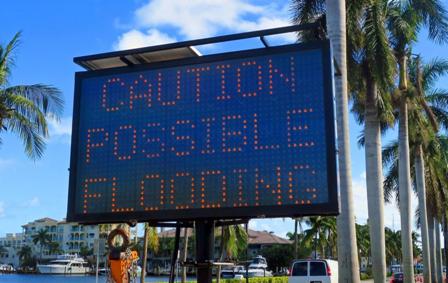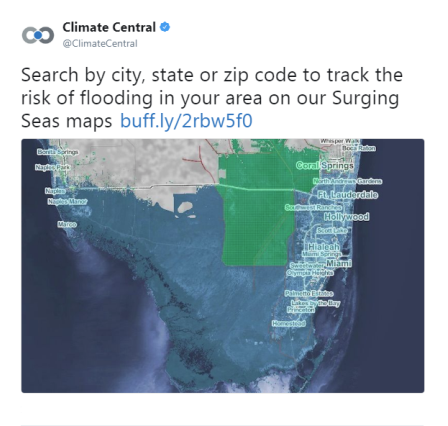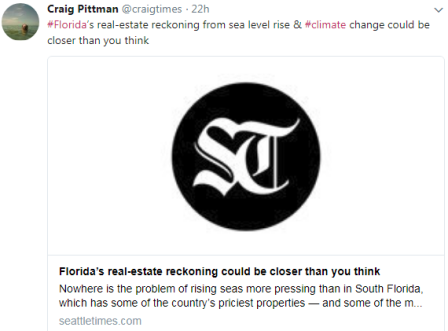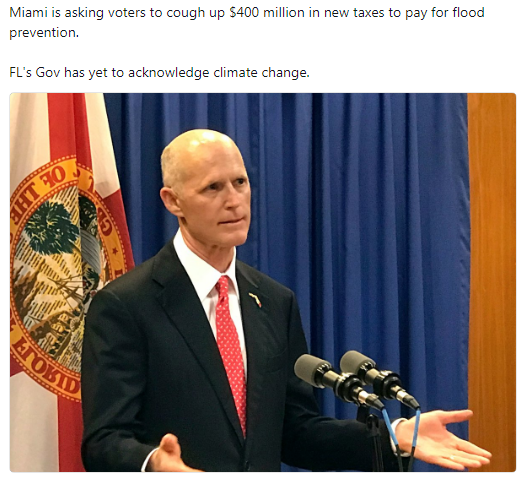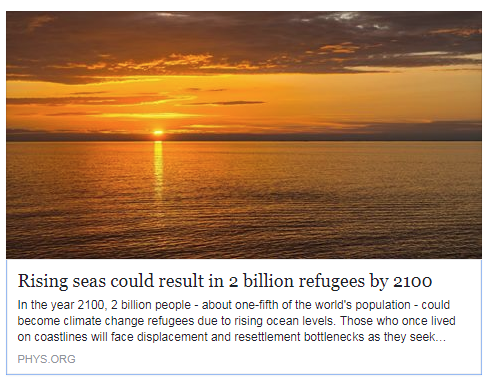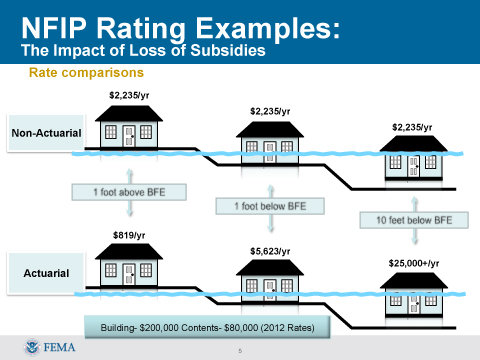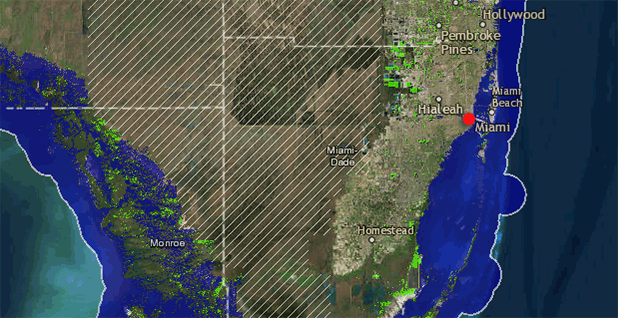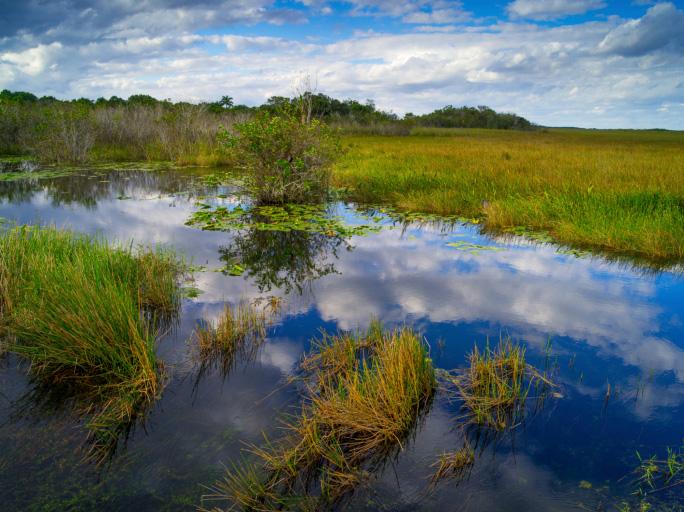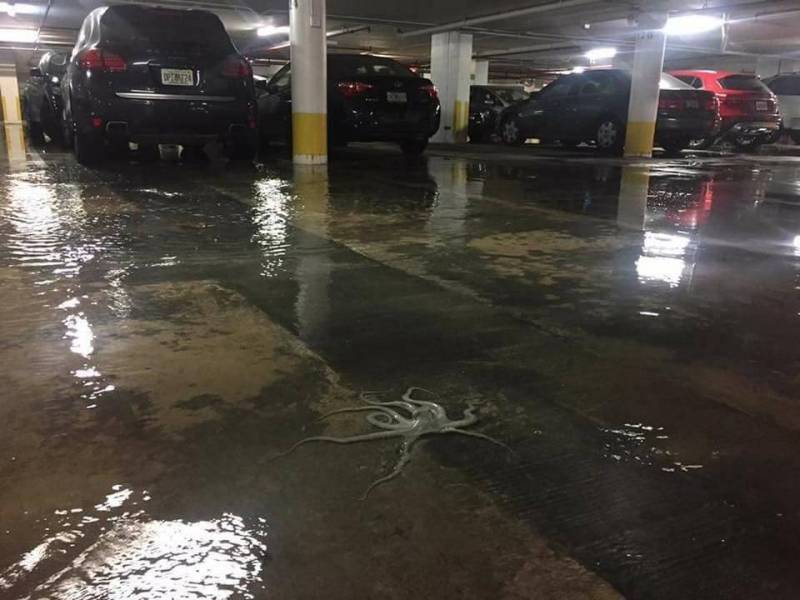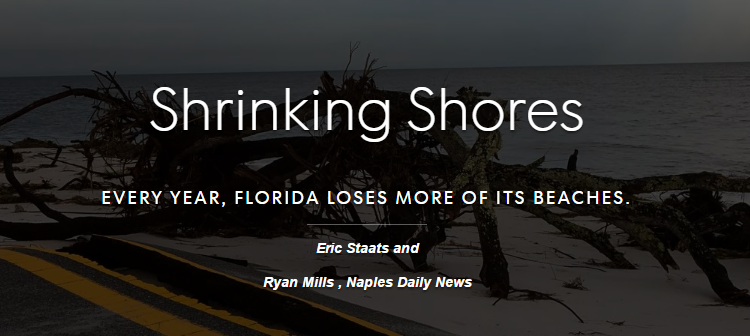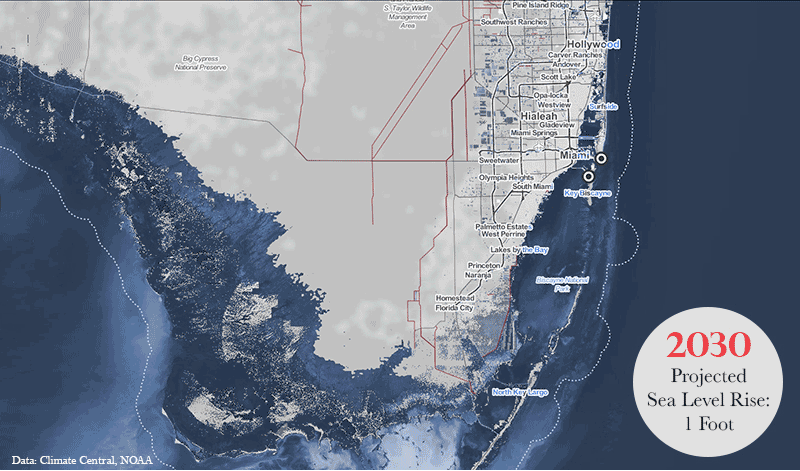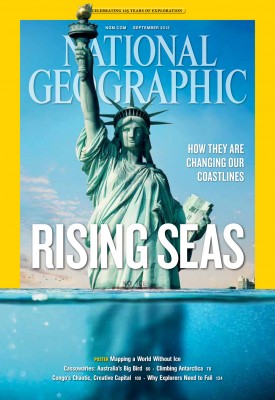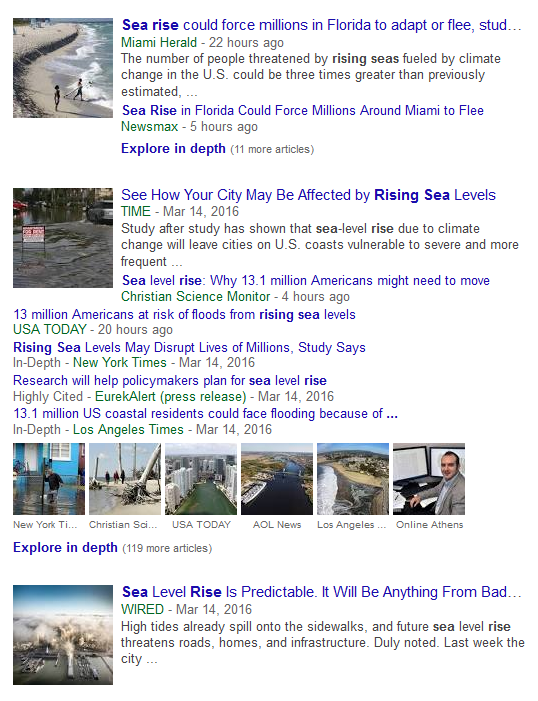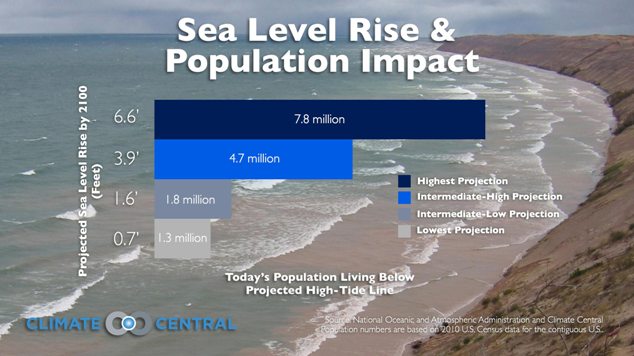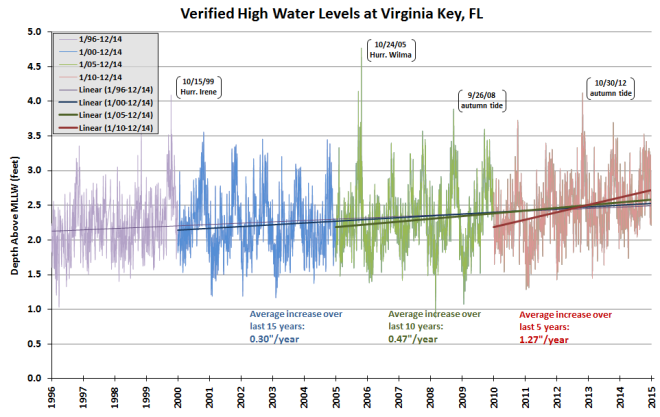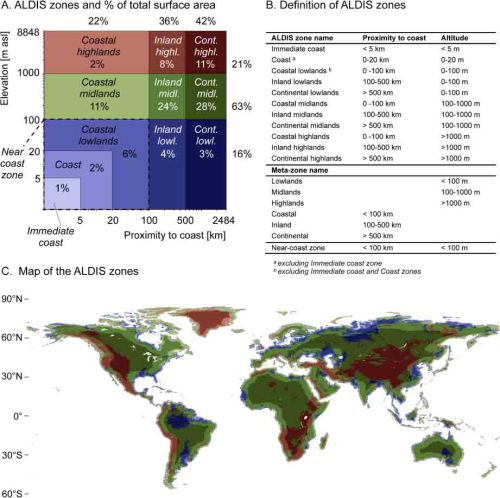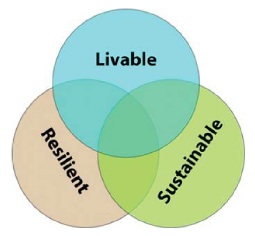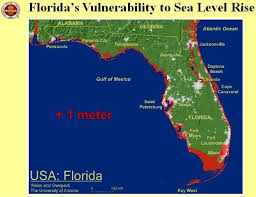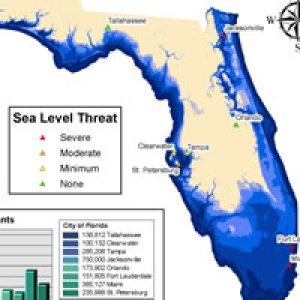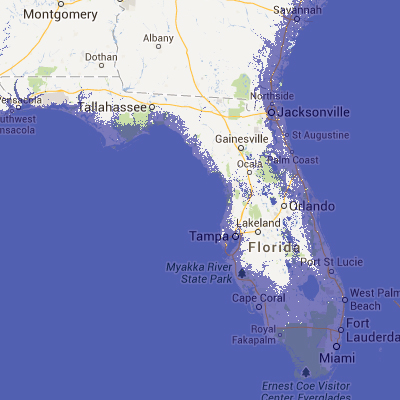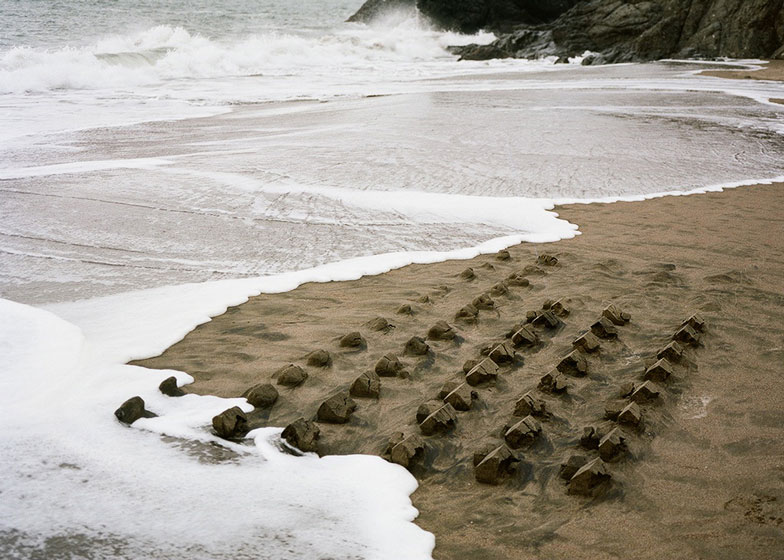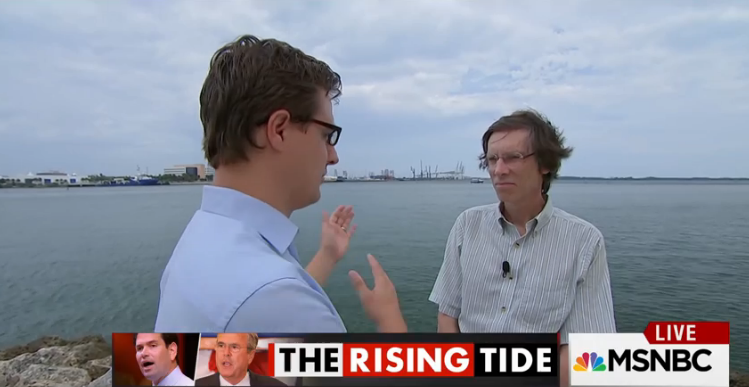Sea-Level Rise: Difference between revisions
Siterunner (talk | contribs) No edit summary |
Siterunner (talk | contribs) No edit summary |
||
| Line 7: | Line 7: | ||
''"Take the six million people who live in south Florida today and divide them into two groups: those who live less than six and a half feet above the current high tide line, and everybody else."'' | ''"Take the six million people who live in south Florida today and divide them into two groups: those who live less than six and a half feet above the current high tide line, and everybody else."'' | ||
''Read [https://www.amazon.com/Rising-Dispatches-New-American-Shore/dp/1571313672/ref=sr_1_1?ie=UTF8&qid=1530039912&sr=8-1&keywords=rising+by+elizabeth+rush '''"Rising: Dispatches from the New American Shore"''' by Elizabeth Rush]'' | ''Read [https://www.amazon.com/Rising-Dispatches-New-American-Shore/dp/1571313672/ref=sr_1_1?ie=UTF8&qid=1530039912&sr=8-1&keywords=rising+by+elizabeth+rush '''"Rising: Dispatches from the New American Shore"''' by Elizabeth Rush]'' | ||
| Line 12: | Line 13: | ||
[[File:Rising.jpg]] | [[File:Rising.jpg]] | ||
······································································································· | |||
Revision as of 19:12, 26 June 2018
June 2018
Rising Seas: 'Florida is about to be wiped off the map'
"Take the six million people who live in south Florida today and divide them into two groups: those who live less than six and a half feet above the current high tide line, and everybody else."
Read "Rising: Dispatches from the New American Shore" by Elizabeth Rush
·······································································································
Via Tampa Bay Times
Report: 40 percent of Florida property will be ‘highly exposed’ to flooding
One of Florida’s biggest draws is also one if its biggest liabilities — its coastline. A new report projects that Florida is at the greatest risk of any state for tidal flooding caused by rising sea levels. And Tampa Bay faces some of the greatest risk within the Sunshine State.
According to a Monday report by the Union of Concerned Scientists, nearly 40 percent of the state’s property tax base is expected to be "highly exposed" to such flooding within the next 30 years.
By 2045, nearly 64,000 residential properties in the state — worth about $26 billion— are at risk for constant flooding. By 2100, about 1 million properties — worth $351 billion — will be at risk. ("You better hope I’m wrong about flood insurance" -- John Romano / Tampa Bay Times: ) "Once market risk perceptions catch up with reality, the potential drop in Florida’s coastal property values could have reverberations throughout the economy — affecting banks, insurers, investors, and developers — potentially triggering regional housing market crises."
Mapping Sea-level Rise in Florida
Coastal Risk Consultants, which raised $2 million to develop software to evaluate individual parcels for flooding, is on the cusp of profitability, said President Albert Slap.
“I just think as a practical matter, this is something people should do,” said homebuyer Kevin Kennedy, who ordered four reports from Coastal Risk Consulting on Palm Beach County properties along the Intracoastal and on the ocean. “The results discouraged me from purchasing two of them.”
·······························································································································
Underwater: Rising Seas, Chronic Floods, and the Implications for US Coastal Real Estate
·····················
May 2018
"The "living shoreline" is the best defense against sea-level rise."
-- Jack E. Davis, author of "The Gulf: The Making of An American Sea
Follow Hashtag #Resilience on Twitter
Miami
Tampa Bay
Three newspapers confront one challenge:
MIAMI HERALD EDITORIAL BOARD
May 04, 2018
No graver threat faces the future of South Florida than the accelerating pace of sea-level rise. In the past century, the sea has risen 9 inches in Key West. In the past 23 years, it’s risen 3 inches. By 2060, it’s predicted to rise another 2 feet, with no sign of slowing down.
Think about that. Water levels could easily be 2 feet higher in 40 years. And scientists say that’s a conservative estimate. Because of melting ice sheets and how oceans circulate, there’s a chance South Florida’s sea level could be 3 feet higher by 2060 and as much as 8 feet by 2100, according to the National Oceanic and Atmospheric Administration.
It’s not just a matter of how much land we’re going to lose, though the barrier islands and low-lying communities will be largely uninhabitable once the ocean rises by 3 feet. It’s a matter of what can be saved. And elsewhere, how we’re going to manage the retreat...
·········································
Twitter / Miami sea level rise
April 2018
Miami / Miami Beach, a Race Against Time
Via Fortune / Wall Street Journal / Real Estate - Climate Change
Rising Sea Levels Reshape Miami’s Housing Market
Properties on the coast now trade at discounts as flood waters and ‘king tides’ damp enthusiasm for oceanfront living.
New research shows that real estate properties in areas affected by extreme weather and sea level rise are losing value relative to less exposed properties. The effects are already substantial, but they may point to a looming collapse as climate change makes coastal communities untenable.
Work by Harvard researchers published last week and highlighted by the Wall Street Journal finds that, after accounting for an array of other factors, home prices have appreciated more slowly in lower-lying areas of Miami-Dade County, particularly Miami Beach. A broader study using data from Zillow, still under peer review, found that properties exposed to rising sea levels sell at a 7% discount to comparable properties not subject to climate-related risk.
As many as 13% of Americans are still convinced climate change isn’t happening at all, and 30% are confident that humans play no role in it. But real estate prices now seem to confirm the chestnut attributed to author Philip K. Dick: “Reality is that which, when you stop believing in it, doesn’t go away.”
○
Yale.edu / Why Seas Are Rising Faster on U.S. East Coast
- Along the southeastern coast of the U.S., researchers have zeroed in on three factors that have made this shoreline a regional hot spot of sea-level rise. They include a slowing Gulf Stream, shifts in a major North Atlantic weather pattern, and the effects of El Niño climate cycles.
- “These coastal areas are more vulnerable than they realize to short-term rapid acceleration of sea-level rise,” says Andrea Dutton, a University of Florida geologist who studies the history of sea-level fluctuations. “If they’re hanging their hat on sea level rise projections looking at the potential over decades, they need to refocus and think about the potential for short-term variability in that rate.”
○
Sea-level Rise Now and Tomorrow
- The ground under the cities of South Florida is largely porous limestone, which means water will eventually rise up through it.
- “Our underlying geology is like Swiss cheese...”
- -- Mayor Philip Levine, running for Florida Governor
March 2018
Scientists continue to study the questions that need to be asked
When projecting future sea levels, scientists have traditionally relied upon physical models and expert assessments to project the polar ice sheets’ response to various emission scenarios. These approaches, however, haven’t taken into account some physical processes that can quickly increase ice sheet discharge, such as the collapse of terminal ice cliffs and the breakup of floating ice shelves caused by a process known as hydrofracturing.
Now Robert Kopp et al. have integrated both of these processes into a probability-based modeling framework to explore how they could affect future projections of global and local sea level changes. The results indicate that these mechanisms could significantly raise sea level forecasts for high-emission scenarios, including nearly doubling the median projections of 21st century global mean sea level rise by 2100.
January/February 2018
Risk Finder & Map
Projections, analysis, comparisons, and downloadable data and local reports
Coastal flood and sea level threats to people, property and infrastructure
For cities, counties, states, ZIP zones...
○ ○ ○ ○ ○ ○ ○ ○ ○ ○ ○ ○ ○ ○ ○ ○ ○ ○ ○ ○
Protecting America's 'Borders'
Via Bulletin of the Atomic Scientists / by Dawn Stover / January 2018
The US-Mexican border is 1,954 miles long. America’s “general” coastline is far longer: 12,479 miles. Measuring the shoreline using smaller-scale charts, and including features such as bays and offshore islands, brings the total to more than 88,000 miles, not including the Great Lakes. The shoreline of Florida alone is more than four times the length of the US-Mexican border.
Coastal counties are home to nearly 40 percent of the US population. With the exception of Alaska, these counties are five times as densely populated as the rest of the nation. “If the nation’s coastal counties were an individual country, it would rank third in the world in gross domestic product, surpassed only by the United States and China,” according to the National Oceanic and Atmospheric Administration (NOAA) Office for Coastal Management.
Coastal areas are also the most vulnerable to the impacts of climate change: rising sea level, shoreline erosion, flooding, contaminated drinking water, ocean acidification, harmful algal blooms, coral bleaching, and more. “By 2050, up to $106 billion worth of coastal property will likely be below sea level” if we continue with business as usual, says NOAA. “There is a 1-in-20 chance—twice as likely as an American developing melanoma—that by the end of this century, more than $1 trillion worth of coastal property will be below mean sea level or at risk of it during high tide.”
December 2017
- What Will Be Will Be? "Ice Apocalypse" or "Doomsday Glacier"?
Attorney Richard Jacobs of St. Petersburg, Florida explains: “All the studies show that 80 percent of Floridians live in a coastal community. Once those communities can no longer support those people and start to have problems, the revenue stream has got to reduce, and that’s just the time you need more revenues to keep up with the maintenance of your coastal communities.” But political powers that be in Florida are in denial of climate change and certainly don't want to talk, or plan, for coming tides of change...
Among the starkest markers of sea level rise are what scientists describe as ghost forests, coastal thickets left in waste by creeping salt water... bellwethers of accelerating sea level rise...
November/October 2017
South Florida local governments, mindful that the region’s boomtown economy might damn well drown if the ocean rises (as climate scientists suggest) 10 inches over the next 15 years, have formed a regional compact to fight climate change.
Floridians have the most to lose if climate change can’t be stanched...
Climate Central catalogued the 25 American cities with the largest number of residents threatened by sea level rise and climate change.
New York, of course, has the largest population situated in threatened areas — 245,000. But Florida cities, most of them in South Florida, utterly dominated the list.
September 2017
- Vulnerability reduction is a real-time opportunity. -- Andy Revkin
Dear Florida Governor Rick Scott: Speaking of the business of politics and planning ahead...
Let's take time to look carefully at "How extreme weather risk is creating a real estate insurance disaster"
... (A)s Harvey’s full significance comes into focus over the next weeks and months, flood insurance, one of the pillars of local rebuilding efforts, will be in the spotlight. Early estimates suggest the losses may hit $10 billion to $20 billion, making it one of the 10 costliest hurricanes in U.S. history.
By September 30, Congress must reauthorize the National Flood Insurance Program (NFIP), a crucial government program that helps pay for and provide policies for millions of properties in at-risk areas across the country. The impact of Harvey on the NFIP is yet unknown, but is clearly expected to be sizable; in Harris County, Texas, the flood program holds more than 240,000 policies, representing more than $60 billion in coverage, according to AIR Worldwide.
In other words, just as the nation begins to figure out how to pay for one of the costliest natural disasters in its history, the insurance program that functions as a backstop for hundreds of thousands of affected properties will be up for debate and renewal.
Battered by recent disasters, hurricanes, and floods, the NFIP is currently $24.6 billion in debt to the U.S. Treasury. That means Harvey may well push the flood program up against its borrowing limit of $30 billion and require further action from Congress to reform the program.
If it’s allowed to lapse, according to a spokesperson from the Federal Emergency Management Agency (FEMA), which oversees the NFIP, it won’t be allowed to sell or renew flood insurance policies, pay existing claims, or start any mapping or management activities to create accurate assessments of risk.
At a time of increased political polarization — especially around the question of climate change and its relationship to the kind of inclement weather events that trigger billion-dollar payments from the NFIP — a chance to reconsider how we develop, build, and plan our communities — and make them more resilient — may be lost to more immediate financial and political needs.
○
The Sea Level Did, in Fact, Rise Faster in the Southeast U.S.
From 2011 to 2015, the sea level along the southeastern American coastline rose six times faster than the long-term rate of global increase.
In an AGU research paper published online this week, University of Florida researchers calculated that from 2011 to 2015, the sea level along the American coastline south of Cape Hatteras rose six times faster than the long-term rate of global increase.
The short tide gauge records revealed that sea level in southeast Florida, for example, rose at a rate of 3-4 mm/yr from 1996 to 2010. This observed rate was between the global mean sea level rise/SLR and 33% faster, and increased 6-fold to greater than >20 mm/yr between 2011 and 2015. A similar acceleration in sea level appeared in all tide gauge records we analyzed south of Cape Hatteras.
○
Unprepared for the Rising Sea
Adm. Paul Zukunft, U.S. Coast Guard commandant: National Public Radio Interview
What Is the Cost of One Meter of Sea-Level Rise? Union of Concerned Scientists (UCS)
When Rising Seas Hit Home: Hard Choices Ahead for Hundreds of US Coastal Communities (UCS/PDF)
In a major study release in July, the Union of Concerned Scientists found that, in the absence of preventative measures, Americans can expect the following:
• Within 20 years, by 2035, nearly 170 coastal US communities — roughly twice as many as today — will reach or exceed the threshold for chronic inundation, given moderate sea level rise. Seventy percent of these will be in Louisiana and Maryland, where land subsidence is contributing to rapid rates of sea level rise. More than half of these 170 communities are currently home to socioeconomically vulnerable neighborhoods.
• Within 45 years, by 2060, more than 270 coastal US communities — including many that seldom or never experience tidal flooding today — will be chronically inundated, given moderate sea level rise.
• By the end of the century, given moderate sea level rise, nearly 490 communities—including 40 percent of all East and Gulf Coast oceanfront communities — will be chronically inundated.
• Given more rapid sea level rise, nearly 670 coastal US communities will face chronic inundation by the end of the century. This number includes nearly 60 percent of East and Gulf Coast oceanfront communities as well as a small but growing number of West Coast communities.
• Given that same rapid rate of sea level rise, more than 50 heavily populated areas—including Oakland, California; Miami and St. Petersburg, Florida; and four of the five boroughs of New York City—will face chronic inundation by the end of the century.
• By 2100, given this same rapid rate of sea level rise, chronic flooding will engulf at least half the total land area of nearly 40 percent of affected communities, including Cambridge, Massachusetts; Alameda, California; and Miami Beach and Fort Lauderdale, Florida.
• Many communities that never reach the 10 percent threshold of chronic inundation this century are nevertheless expected to see chronic flooding of important areas.
• There is still time to prevent such widespread chronic inundation. Curtailing future warming and, thereby, the acceleration of sea level rise could benefit communities in each coastal region. By reducing global warming emissions, we may slow the pace of sea level rise, which could spare hundreds of communities chronic inundation.
• For hundreds of other communities, chronic inundation is avoidable only through significant adaptation measures, including coastal retreat.
Measures to accommodate or keep water out of communities may forestall the inundation projected by this analysis, but often at great cost and for a limited time. Hundreds of
communities along the coasts, from Maine to Washington State will be forced to make difficult choices about whether and how much to invest in flooded areas versus when to
retreat from them. Many such communities are home to low income residents who have few of the resources they would need in order to move or to adapt.
Large-scale reductions in global warming emissions, similar to those planned under the international climate deal known as the Paris Agreement, may slow the rate at which sea level rise is accelerating and save many communities from chronic inundation. For hundreds of other cities and towns, however, increased flooding is inevitable, and adaptation is now essential.
By making sound decisions soon, communities can prepare for chronic inundation in the time they have and avoid serious losses — not only of homes, schools, businesses, and other infrastructure, but also of regional history, sense of place, local culture, and people’s ways of life.
Today, high tide flooding is shifting from a nuisance to a costly, disruptive problem in locations like Miami Beach, pictured here in 2015. Though the flooding has not reached our threshold of chronic inundation, major investments are underway in Miami Beach to address it nonetheless. Around the US coast, as this flooding approaches chronic levels — regularly preventing people from leaving their houses without wading through saltwater, driving their cars without incurring saltwater damage, getting safely to and from school, work, appointments and errands — people will be forced to ask how long they can live with it.
○
June/May 2017
U.S. Flood Insurance, Deep in Debt, Attempts to Deal with the Future
- Currently, the US federal flood insurance program (NFIP) takes in about $3.5 billion in revenue each year, and covers about $1 trillion in risk.
- Both political parties say they support more voluntary buyouts of homes that repeatedly flood. Under that approach, the federal government uses money that comes in through flood insurance policies to purchase high-risk homes, then demolishes them. Expanding those buyouts could shrink neighborhoods along the Atlantic and Gulf Coasts, in such places as New Jersey, Virginia, Florida and Louisiana.
- More on Direct/Indirect Costs: http://www.businessinsurance.com/article/20170419/NEWS06/912312990/NFIP-restructuring-needed-as-sea-levels-rise
- https://www.fema.gov/media-library/assets/documents/83905 -- https://www.fema.gov/media-library-data/41ecfedd3b889396440c30d34b9b91ea/Agent_Quick_RefGuide_September_2013.pdf
- Case Studies: http://www.tampabay.com/news/business/banking/romano-either-fix-flood-insurance-system-or-be-prepared-for-disaster/2290280
○
Via Josh Kurtz / E&E News
Migration Inland as Real Estate Speculation Shifts
Florida's Barrier Island Blues
"Oh, Miami Beach is going under, the sea level is coming up," Harewood said. "So now the rich people have to find a place to live. My property is 15 feet above sea level, theirs is what? Three under?
One of the great ironies of historic housing patterns in Miami is that for decades under Jim Crow, laws and zoning restricted black people to parts of the urban core, an older part of the community that sits on relatively higher ground along a limestone ridge that runs like a topographic stripe down the eastern coast of South Florida. Now, many of those neighborhoods, formerly redlined by lenders and in some places bound in by a literal color wall, have an amenity not yet in the real estate listings: They're on higher ground and are less likely to flood as seas rise...
No one can turn a blind eye to the projections everyone uses in South Florida: 2 feet of sea-level rise by 2060.
"Everybody I know that is a small owner of real estate that isn't within the billionaire class — average middle-class, upper-middle-class Miamians who have real estate on the beach — is in the process of selling their properties and moving to the mainland... Basically where the coral ridge is, just north of downtown and south of downtown, that's where anecdotally the most amount of speculative investment has been going in because historically that's been the highest ground."
○ ○ ○ ○ ○ ○ ○ ○
A "Nightmare Scenario" for Florida
○ ○ ○ ○ ○ ○ ○ ○ ○ ○ ○ ○ ○ ○ ○
Mar-a-Lago sitting on a shifting 'barrier island' in Palm Beach, Florida
March 2017
February 2017
- https://www.epa.gov/arc-x/southwest-florida-assesses-salt-marsh-vulnerability-sea-level-rise
- http://www.ocregister.com/articles/marshes-418263-ocprint-salt-wildlife.html
- http://www.pressherald.com/2017/02/11/rachel-carson-national-wildlife-refuge-in-wells-is-losing-ground-to-erosion/
- https://www.nytimes.com/2017/01/19/nyregion/bronx-marsh-sea-level-rise.html
- January 2017
December 2016
Not far from Mar-a-Lago, the U.S. president elect's Florida estate, the tides are rising higher in Miami.
- Via the Miami Herald, here's an octopus in a parking garage as a sign of things to come from rising South Florida seas.
http://www.tcpalm.com/story/news/special-reports/2016/11/11/sand/93320976/
○
On the Election of a New U.S. President
○
Florida, Sea-Level Rise Reality
The Florida peninsula, with much of it close to sea level, and underlying karst/limestone landscape, sea-level rise will deliver salt-water intrusion into the aquifer.
As evidenced with coastal "Ghost Forests", salt water movement into fresh water coastal zones and then inland into groundwater will be disruptive and act to foreshadow devastating environmental results.
○ ○ ○ ○ ○ ○ ○ ○ ○ ○ ○ ○
A steady increase in sea levels is pushing saltwater into U.S. wetlands, killing trees from Florida to as far north as New Jersey. But with sea level projected to rise by as much as six feet this century, the destruction of coastal forests is expected to become a worsening problem worldwide.
On a recent afternoon, University of Florida watershed ecologist David Kaplan and Ph.D. candidate Katie Glodzik hiked through the Withlacoochee Gulf Preserve, on the Big Bend coast of northwestern Florida. Not long ago, red cedar, live oaks, and cabbage palms grew in profusion on the raised “hammock island” forests set amid the preserve’s wetlands. But as the researchers walked through thigh-high marsh grass, the barren trunks of dead cedars were silhouetted against passing clouds. Dead snag cabbage palms stood like toothpicks snapped at the top. Other trees and shrubs, such as wax myrtle, had long been replaced by more salt-tolerant black needlerush marsh grass.
Saltwater, flowing into this swampy, freshwater-dependent ecosystem as a result of rising sea levels, is turning these stands of hardwoods into “ghost forests” of dead and dying trees.
Read More: http://grist.org/article/ghost-forests-are-eerie-evidence-of-rising-seas/
○ ○ ○ ○ ○ ○ ○
October 2016
Rising seas image courtesy of Isaac Cordel
"What's Your Elevation Above Sea Level?", he asked nonchalantly
Coastal areas around the globe are losing ground to the sea — and faster than ever. In the past quarter-century alone, the ocean has risen an average of almost 3 inches. With nearly half the world’s population living within 93 miles of a coast, and much of the globe’s commerce concentrated there, sea level rise looms as one of the greatest of all climate change effects...
○
More Miami, Under and Over, the Sea's Bubbling Up
- This story was originally published in Spanish at CityLab Latino.
The water rose quickly. At noon on a brilliantly sunny day here, several blocks from the beach, a lake of salt water suddenly appeared in the street, filtered up from the porous limestone that resides underneath the whole county of Miami-Dade....
○ ○ ○ ○ ○ ○ ○ ○
September 2016
The Florida flooding stories continue, as the Republican party and political candidates continue political evasion...
“Donald Trump lives in a parallel universe where the facts established by the scientific community to him don’t exist,” said Anthony Leiserowitz, director of the Climate Change Communication program at Yale University.
“The fact is that climate change is here and now. It’s not some faraway, distant problem that we’re not going to see for a generation or two.”
Alarmed by the threat to Florida’s giant tourism industry, Miami business leaders have championed a public works overhaul.
“We know the stakes,” said Mark Rosenberg, chairman of the Greater Miami Chamber of Commerce. “At 5 feet over current levels, much of suburban Miami, including Miami Beach, is completely submerged.”
To Doug Yoder, deputy director of the Miami-Dade Water and Sewer Department, the debate over climate science ended long ago.
“There’s a point beyond which habitability, certainly at the scale and density that southeast Florida is currently developed to, would not be feasible,” he said. “Whether that point is 3 feet of sea-level rise, or 6 feet of sea-level rise, certainly at 10 feet of sea-level rise, there is a point of no return.
“The only way that point of no return could be avoided would be to effectively address greenhouse gas emissions.” And that, he said, “has to be managed at a global scale.”
○
Last fall, an exceptionally high tide flooded Miami Beach’s streets and forced tourists to slosh their way to their hotels. As global warming accelerates the rise of the sea level, the state of Florida and some local governments want to fight for their own survival, but Harold Wanless and Philip Stoddard are urging a reality check: Global warming, they say, will drown South Florida. It can’t be reversed.
○ ○ ○ ○ ○ ○ ○ ○ ○ ○ ○ ○ ○ ○ ○ ○ ○ ○ ○ ○
August 2016
@EarthVitalSigns #EarthRightNow
2016: Reddit AMA: Science-Sea Level Rise
○ ○ ○ ○ ○ ○ ○ ○ ○ ○ ○ ○ ○ ○ ○ ○ ○ ○ ○ ○
July 2016
At Ground Zero for Rising Seas, TV Weatherman Talks Climate
June 2016
- Discover Magazine: "How many cities will our oceans swallow?"
- --*Giving 'Underwater Mortgages' New Meaning"
May 2016
- To combat flooding, Miami Beach has launched a $400 million project that's begun installing as many as 80 pump stations throughout the city...
NPR / As Waters Rise, Miami Beach Builds Higher Streets And Political Willpower
○ ○ ○ ○ ○ ○ ○ ○ ○ ○ ○ ○ ○ ○ ○ ○ ○ ○
U.S. Presidential Campaign
Trump v the World: Announces his Energy policy
- Republican presidential candidate -- Cancel the Paris agreement, More fossil fuels, Less Clean/Renewable Energy
- In a speech laying out his energy agenda for the United States, Trump promised to undo essentially every major policy developed in last decade intended to slow human-caused global warming.
Trump declares he doesn't believe the science, believes climate change a hoax and 'BS'
- Trump tweet: This very expensive GLOBAL WARMING bullshit has got to stop. 'Environmentalists are the problem', acc to the Republican candidate for president
- Our planet is freezing, record low temps,and our GW scientists are stuck in ice
○
Republicans in US Congress Vote to Block National & Global Security
- Attempt to Defund and Block Defense Dept. Studies and Work Related to Impacts of Climate Change
Experts Warn of 'Significant' Global Sea-Level Rise as the Antarctic Impacted by Global Warming
○
http://www.nytimes.com/2016/03/31/science/global-warming-antarctica-ice-sheet-sea-level-rise.html
http://blogs.agu.org/wildwildscience/2016/04/04/science-gets-better-news-gets-worse-sea-level-rise/
... for the first time, researchers used a series of coupled models to produce a more realistic look at what will happen to Antarctica in the coming decades and centuries. There has been a lot of uncertainty about how quickly the ice shelves could collapse, and even a decade ago the IPCC was saying that there was too much uncertainty to forecast it reliably. Since then, the science has improved, and the news has gotten worse.
U.S. Presidential Campaign: Environmental Threats
- Environmental Scorecard: Cruz voted against every green bill,
- and opposed every pro-environment, anti-pollution piece of legislation
Trump declares he doesn't believe the science and believes climate change a hoax
○ ○ ○ ○ ○ ○ ○ ○ ○ ○ ○ ○ ○ ○ ○ ○ ○ ○ ○ ○ ○ ○ ○ ○ ○ ○ ○ ○
March 2016
- Politico / March 14, 2016
- How Miami Beach Is Keeping the Florida Dream Alive — And Dry
- Beset by rising seas and indifferent legislators, the city is spending big to keep its economy above water
- There’s just no getting away from the rising sea...
Across the country, even the world, coastal cities are the front lines of climate-change planning, leap-frogging past the political debate to hatch immediate and often very expensive plans to fight the effects they are already living with. Miami Beach, all seven square miles of it, has placed itself at the leading edge of an existential fight facing the entirety of South Florida—230 miles of coastline running from Key West to Palm Beach. Driven by global warming, the sea level here has risen 9 inches over the past century and is predicted to rise at an accelerating pace by as much as another 6½ feet by 2100. Even the most conservative scientists anticipate a rise of at least 2 feet by 2060...
○
Florida mayors press presidential debate moderators for climate airtime
Mayors of 21 cities in Florida called on the moderators of presidential debates in Miami to ask candidates how they would deal with rising sea levels caused by climate change, a concern of the state's coastal communities.
"It would be unconscionable for these issues of grave concern for the people of Florida to not be addressed in the upcoming debate you will be hosting in the state," the mayors wrote in an letter to CNN, The Washington Post, Univision and the other media outlets hosting the Democratic and Republican debates on March 9 and March 10 in Miami.
○
Another in Series of NASA Earth Science Satellites Launched
Ocean Science: Studying Sea-Level Rise
Jason-3 in Orbit - http://www.nasa.gov/press-release/jason-3-launches-to-monitor-global-sea-level-rise
https://blogs.nasa.gov/Jason-3/
Confirmation has arrived via the Fairbanks, Alaska tracking station that Jason-3’s solar arrays are, indeed, out. The twin Jason-3 solar arrays have been extended and the spacecraft is power positive, flying in its planned orbit of 66 degrees to the Earth’s equator : 3:21 pm EST
○
The Presidential campaign comes to the 'Sunshine State'
Sunshine state pol updates -- Some environmental Carl Hiaasen riffing on Florida's Gov Scott, and an e-bit of Clinton & Sanders from today's Miami Herald & TampaBay Times.
Clinton "mocked the Scott administration's directive to state employees not to use the words "climate change" and pledged to support renewable energy in Florida."
"Of Scott's order to state employees, she said: "I found this one hard to believe. I mean, you've just got to shake your head at that."
"When Republicans say they can't talk about climate change because they're not scientists, Clinston said, there's a cure for that: "Go talk to a scientist."
Sanders "also criticized Republicans for their obstinance on climate change, which he said is holding Florida back from becoming a leader in renewable energy."
"The state of Florida has an extraordinary natural resource: its called sunlight," Sanders said, "and this state should be a leader in the world in producing solar energy."
And from Florida, an Editorial re: political moves in the "Sunshine State"... misnaming a constitutional amendment that would, in effect, *prevent sunshine/solar energy* from competing w/ the fossil fuel industry. The issue is now before the Court. Ivan Penn formerly w/ the St Pete Times, now w/ the LA Times, wrote extensively about energy issues in Florida. What a long-running story it is. Today's Tampa Bay Times Editorial speaks of the latest chapter of public good v energy industry-lobbying power...
○ ○ ○ ○ ○ ○ ○ ○ ○ ○ ○ ○ ○ ○ ○
Feb 2016
- Seas Are Rising at Fastest Rate in Last 28 Centuries
- Temperature-driven global sea-level
Florida Is Sinking: Where Is Marco Rubio?"
- 15 South Florida Mayors Request Climate Change Mtg with Senator Rubio
- MIAMI, FL — Mayors representing more than 920,000 South Florida residents released a letter sent to Senator Marco Rubio requesting a meeting to discuss the risks facing Florida communities due to climate change. The letter, sent to Rubio’s campaign offices last Thursday, highlights the economic toll of climate change in South Florida and asks the candidate to “acknowledge the reality and urgency of climate change and to address the crisis it presents our communities.”
Jan 2016
Heat absorbed by oceans doubles since 1997
Dec 2015
Disappearing coastlines and rising seas:
Nov 2015
Oct 2015
Sept 2015
○ ○ ○ ○ ○ ○
August 2015
NASA: "What's up with sea-level rise?"
Data from NASA coming i/o from JPL US/Euro mission control
http://www.nasa.gov/goddard/risingseas --- http://svs.gsfc.nasa.gov/cgi-bin/details.cgi?aid=11978 --- https://sealevel.jpl.nasa.gov/ --- http://www.washingtonpost.com/news/energy-environment/wp/2015/08/26/the-troubling-reasons-why-nasa-is-so-focused-on-studying-on-sea-level-rise/ --- https://en.wikipedia.org/wiki/Ocean_Surface_Topography_Mission
Why NASA’s so worried that Greenland’s melting could speed up
○ ○ ○ ○ ○ ○ ○ ○ ○ ○ ○ ○ ○ ○ ○ ○ ○ ○ ○ ○ ○ ○ ○ ○ ○ ○ ○ ○
Sea-Level Rise and Coastal Response
- United States -- Case Studies
Adaptation Action Planning
Florida
2015/2014/2013
Five Reasons Why Florida's Senator Rubio (Might Want To) Should Re-think Climate Change
"Climate change could leave the Florida Keys and large parts of the south of the state underwater"
Contrasting Visions
Why Does Florida Have So Many Climate Change Deniers?
Billionaires Charles and David Koch have helped to fuel conservative activism in Florida, by spending millions over the years to establish elaborate political operations in the state. As a result, Florida has become something of a testing ground for anti-government campaigning from the Kochs’ primary group, 'Americans for Prosperity'. A New York Times story last March noted that AFP used a special election for a House seat and “turned the Florida contest into its personal electoral laboratory to fine-tune get-out-the-vote tools and messaging for future elections as it pursues its overarching goal of convincing Americans that big government is bad government.” David Jolly, AFP’s candidate of choice, won that election. Like many of his Florida colleagues, Jolly said he doesn’t think “the impact that humans have had on our climate is so dramatic” that it warrants government action...
○
Miami Could Be a New Atlantis - from a Dutch engineer point of view
“If we look around the world and take into account sea level rise and the increase of water related disasters, among the places in the world that have the most assets and investments at risk, Miami is leading that list,” Henry Ovink tells New Times. “Miami will no longer be a land city, but a city in the sea.” Last year, a New York Times Magazine article about Ovink and Dutch water management efforts showed just how behind the U.S. is in its thinking around water.
Miami is Sinking Already Under Rising Sea Levels
At the University of Miami’s Department of Atmospheric Sciences, Brian McNoldy and other researchers have been accumulating sea-level data from Virginia Key (a small island just south of Miami Beach) since 1996. Over those 19 years, sea levels around the Miami coast have already gone up 3.7 inches. In a post, McNoldy highlights three big problems that follow from those numbers...
Head in Sand / Mar 2015 Florida Officials Say They Were Banned From Saying 'Climate Change' and 'Global Warming'
○ ○ ○ ○ ○ ○ ○ ○ ○ ○ ○ ○ ○ ○ ○ ○ ○ ○ ○ ○ ○ ○ ○ ○ ○ ○ ○ ○ ○ ○
Karst formation/underground will have added impact on sea-level rise/salt water intrusion in Florida
Re: Florida topography: Karst topography is the geological name given to an area of limestone bedrock featuring caves, sinkholes, underground streams and natural springs (Florida has one of the highest concentrations of springs on Earth). In laymen terms, karst topography is anywhere the lower levels of the soil horizon has been dissolved by the physical or chemical weathering of the bedrock. These environments are comprised of carbonate rocks, such as dolomite and limestone, or having high amounts of evaporites, for example, salt and gypsum, as these materials tend to be highly soluble in water. Having these conditions within humid climate like Florida invites faster weathering. Another erosion accelerator is groundwater mixed with vegetation creates a weak acid that dissolves the limestone. (think baking soda mixing with vinegar) Over time, cracks become caves, and when caves collapse they form exposed openings known as karst windows.
Karst topography? Limestone-Carbonate Peninsula? Underground Connected Waterways? Mosaic Corporation Demonstrates a Case Study
What is the connection between the world's largest phosphate production industry, sea-level rise and Florida's underground waterways?
Phosphate has seeded Florida with the environmental equivalent of ticking time bombs
\: https://water.usgs.gov/ogw/aquiferbasics/carbrock.html
Where carbonate rocks are exposed at land surface, solution features create karst topography, characterized by little surface drainage as well as by sinkholes, blind valleys, sinking streams, and mogotes. Because water enters the carbonate rocks rapidly through sinkholes and other large openings, any contaminants in the water can rapidly enter and spread through the aquifers.
○ ○ ○ ○ ○ ○ ○ ○ ○ ○ ○ ○ ○
Read more on Florida risks:
Banned in Florida: Government Frowns on Use of the Term -- "Climate Change"
Rising seas?
- Ban the term 'climate change'...
○
○
Florida International University Researchers Tackle Sea Level Rise
Rising seas in South Florida, PBS-2014 - South Florida Rising Seas - PBS
○
Big Energy companies in Florida look to "gut energy savings goals"
In Florida, fossil fuel energy co's have their way in a pro-fossil fueled legis and w/ the gov. Today we read the energy co's are officially against renewables, incl solar in the "Sunshine State", claiming to the PSC that energy 'savings' are bad (for them) and then there's the 'if they can't grow, they'll die' argument (so pay more, use more, pollute more, greenhouse more, sea rise more, not to worry, bigger better, more better.) What's wrong w/ this picture?
○
A 2014 report released by the research and journalism group Climate Central found that 2,120 square miles of land lie less than 3 feet above the high tide line in Florida. That means 300,000 homes, or around $145 billion in property value, are at risk.... Climate Central found that $71 billion of Florida property sits on land less than two feet above the high tide line.
http://sealevel.climatecentral.org/uploads/ssrf/FL-Report.pdf
○ ○ ○ ○ ○ ○ ○ ○ ○ ○ ○ ○ ○ ○ ○ ○ ○ ○ ○ ○ ○ ○ ○ ○ ○
United States
California
Sea Level Rise Vulnerability Study - City of Los Angeles
Over the next century, sea level rise in the Los Angeles (L.A.) region is expected to match global projections with an increase of 0.1 - 0.6 m (5 - 24 inches) from 2000 to 2050 and 0.4 - 1.7 m (17 - 66 inches) from 2000 to 2100. USC Report
Los Angeles critical coastal infrastructure at the Port of Los Angeles (Port) is approximately 10 ft above sea level. Under current conditions, some of this infrastructure is vulnerable to flooding during high tide events and severe storms. This flooding is expected to worsen as sea level rise contributes to increased total water levels. The Port is among the busiest in the world, contributing more than $63 billion to the State of California, and more than $260 billion to the U.S. economy. More than 40% of all imports arriving in the U.S. comes through the Ports of Los Angeles and Long Beach, where it is loaded onto trucks and trains for overland shipping (Port of Los Angeles 2012)... [1]
California regional - http://climate.calcommons.org/article/regional-strategies-sea-level-rise-adaptation
○ ○ ○ ○ ○ ○ ○ ○ ○ ○ ○ ○ ○ ○ ○ ○ ○ ○ ○ ○ ○ ○ ○ ○ ○
New York City
Startling Maps of How New York City Will Be Hit
- CityLab Maps
- With five more feet of ocean, everything from Canarsie to Coney Island would be submerged
- Not to Worry: It's in the Distant Future (Not)
○
Post Superstorm Sandy, estimated $29 Billion plan sets stage for future [2] Mayor's Plan to Protect NYC A Stronger, More Resilient New York [3] Superstorm barrier for New York - June 4, 2014 13 Mile Long Levee at tip of Manhattan
In a settlement that could have far-reaching implications nationwide, New York’s largest utility is now responsible for preparing for a future of extreme weather, including the impacts of climate change. June 5, 2014 [4]
NY/NJ Sea Rise Assessment 2013
○ ○ ○ ○
Global and Regional Sea Level RiseScenarios forUS (pdf)
File:Global and Regional Sea Level Rise Scenarios for US.pdf
U.S.
Ways Cities are Preparing for Sea-Level Rise
"Global sea-level rise (SLR) trends provide valuable evidence in preparing for future environmental change" explains a 2012 US NOAA report which goes on to say aside from this report, there is currently no coordinated, interagency effort in the US to identify agreed upon global mean SLR estimates for the purpose of coastal planning, policy, and management. -- Scenarios/NOAA/Nov 2012
Soon after this acknowledgment of a systemic lack of coordinated, interagency planning, a follow-on assessment is issued by "twelve contributing authors" from "ten different federal and academic science institutions." NOAA/Dec 2012
"A new sea level rise scenarios report has been released by NOAA's Climate Program Office in collaboration with twelve contributing authors from ten different federal and academic science institutions. The report, produced in response to a request from the U.S. National Climate Assessment Development and Advisory Committee, provides a synthesis of the scientific literature on global sea level rise, and a set of four scenarios of future global sea level rise." Global Sea Level Rise Scenarios for the United States National Climate Assessment
○
US Pentagon Prepares for Climate Change
○
Global
Sea level rises poses greater threat to billions / March 2016
○
via New Zealand Herald/Science
○
Sept 2015
"Climate Change, the Fate of Antarctica and Global Sea-level Rise"
New evidence suggesting a behemoth "sleeping giant" ice sheet is more sensitive to climate change than ever thought... the ice sheet, which forms most of Antarctica, would contribute an equivalent of around 50 metres of sea level rise - the vast majority of the total 58 metres that could come from the frozen continent.
The part of the ice sheet that rests on bedrock below sea level is most vulnerable and holds an equivalent of 19 metres of sea level rise.
In the face of climate change, which has brought warmer ocean water to the edges of Antarctica, the vast ice sheet has been long regarded by scientists to be much more stable when compared with the smaller, 25 million square kilometre West Antarctic Ice Sheet, which satellite measurements estimated was losing more than 150 cubic kilometres of ice each year.
But an Australian expedition that managed to reach the typically inaccessible Totten Glacier in East Antarctica in January revealed some of the first direct evidence that warmer waters were having a significant impact...
"In general, all of the evidence we have from the ice, from the atmosphere, and from the top to the bottom of oceans, is that the Southern Ocean is having an impact on Antarctica and an impact on our climate.
"The evidence is just becoming more and more clear that change is underway - and work by my colleagues all around the world is showing these changes are a result of human activity. It's not just a natural cycle we are seeing."
Dr Stephen Rintoul has led 12 expeditions to Antarctica and coordinated the major international Southern Ocean climate research programmes conducted over the past 25 years...
The new findings link in with what is another big part of Dr Rintoul's work - the role of oceans in climate change.
"One of the things that many people don't realise is that, in a sense, global warming is ocean warming - more than 93 per cent of the extra heat that's been stored by the planet over the last 50 years is found in the oceans.
"So that means if we want to understand how the climate is evolving and how the climate is changing, we need to be tracking and understanding what's happening in the oceans..."
○ ○ ○ ○
August 2015
Rising Sea Level Threat: Glaciers 'Beyond the Point of No Return'
Glaciologist Eric Rignot of the UC-Irvine and NASA’s JPL and lead author of a West Antarctic study, stated that East Antarctica’s ice sheet remains a wildcard.
“The prevailing view among specialists has been that East Antarctica is stable, but we don’t really know,” Rignot stated. “Some of the signs we see in the satellite data right now are red flags that these glaciers might not be as stable as we once thought.”
Exactly how much rise will happen and when is uncertain, they say. “We’ve seen from the paleoclimate record that sea level rise of as much as 10 feet in a century or two is possible, if the ice sheets fall apart rapidly,” said Tom Wagner, the cryosphere program scientist at NASA Headquarters in Washington. “We’re seeing evidence that the ice sheets are waking up, but we need to understand them better before we can say we’re in a new era of rapid ice loss.”
○ ○ ○ ○ ○ ○ ○ ○ ○ ○ ○ ○
Resilient Strategies for responding to sea-level rise
Resilient Cities - Resilient Communities
Integrating Best Practices into Planning
"With identification of risks inherent in the forces of nature, government acquires responsibilities to address those risks..."
Sea-level rise mitigation policies
Disaster Preparedness/FEMA - PDF
http://climate-l.iisd.org/news/iclei-partners-summarize-implications-of-ar5-findings-for-cities/
○
Against the Tide book by Cornelia Dean
From Publishers Weekly
An eloquent, forceful plea to save America's rapidly eroding beaches and coastline, this revelatory and disturbing report from the science editor of the New York Times is reminiscent of Rachel Carson's Silent Spring...
[Review] Castles built on sand are doomed, they say. But in our hunger for an ocean view from the living-room window, we keep building things we expect to last on beaches that never stay still. In Against the Tide, Cornelia Dean, science editor of The New York Times, outlines the global coastal management crisis and all the elaborate engineering methods developed to stave off erosion--revetments, sand-trapping devices, seawalls, groins and jetties, even artificial seaweed beds. In clear, journalistic style, she explains how all of these devices have failed to stop the inexorable march of the sea...
From the motels and T-shirt shops of beachless Florida "beach towns" to Los Angeles County, most of whose beaches are artificial, the story Dean tells is the same. People build on unstable landforms, then attempt to avoid the inevitable consequences through quick technological fixes: concrete seawalls, artificial reefs, sand-trapping steel groins, jetties, underground "dewatering" systems of pipes and pumps, etc. These techno-fixes may prolong the life of coastal buildings, but they usually accelerate erosion and environmental degradation...
Florida (sea-level mapping)
Sea-rise near-, mid-, long-term projections
[6]]
Rising Seas_Art
○ ○ ○
The Dutch know more, oh Florida ...
○ ○ ○
MSNBC Interview with Mayor of South Miami / September 2015
http://www.msnbc.com/all-in/watch/hes-both-a-scientist-and-a-politician-534715971595
○ ○ ○ ○ ○ ○ ○ ○ ○ ○ ○ ○ ○ ○
Eyeballs on Sea-Level Rise
Over 100 thousand top-page views (with thousands more additional shares) of GreenPolicy's sea-level rise pages:
Sea-level Rise category; Sea-Level Rise & Mitigation category; and Sea-Level Rise page
○
- Sea-Level Rise & Mitigation
- Antarctica
- Arctic
- Antigua and Barbuda
- Bahamas
- Barbados
- Belize
- Cabo Verde
- Caribbean
- Climate Policy
- Comoros
- Cook Islands
- Cuba
- Dominica
- Dominican Republic
- Fiji
- Florida
- Global Security
- Greenland
- Grenada
- Guinea-Bissau
- Guyana
- Haiti
- Kiribati
- Jamaica
- Louisiana
- Maldives
- Marshall Islands
- Micronesia
- Nauru
- New Jersey
- New Zealand
- New York
- Niue
- North Carolina
- Oceania
- Palau
- Papua New Guinea
- Samoa
- Saint Kitts and Nevis
- Saint Lucia
- Saint Vincent and the Grenadines
- Sao Tome and Principe
- Seychelles
- Small Island Developing States
- Singapore
- Solomon Islands
- South Carolina
- US
- Anthropocene
- Aquifers
- Atmospheric Science
- Climate Change
- Cryosphere
- Divestment from Fossil Fuels
- Earth
- Earth360
- Earth Imaging
- Earth Observations
- Earth Science
- Earth Science from Space
- Eco-nomics
- Ecology Studies
- Environmental Full-cost Accounting
- Environmental Protection
- Environmental Security
- Environmental Security, National Security
- ESA
- Green Politics
- NASA
- New Definitions of National Security
- NOAA
- Ocean Ecosystem
- Oceans
- Ocean Science
- Planet Citizen
- Planet Scientist
- Planet Citizens, Planet Scientists
- Resilience
- Sea-level Rise
- Strategic Demands
- Sustainability
- Sustainability Policies
- US Environmental Protection Agency
- Whole Earth
